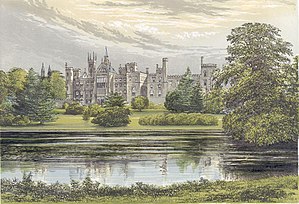History of Alton Towers
| Alton Towers | |
|---|---|

Alton Towers from Morris's Seats of Noblemen and Gentlemen (c.1880)
|
|
|
Location within Staffordshire
|
|
| Alternative names | Alton Abbey |
| General information | |
| Type | Stately Home |
| Architectural style | Gothic Revival |
| Location | Alton, Staffordshire |
| Coordinates | 52°59′9.89″N 1°53′36.30″W / 52.9860806°N 1.8934167°W |
| Current tenants | Merlin Entertainments |
| Completed | 1850 |
| Opened |
1855 as a Gardens 1980 as a Theme Park |
| Renovated | Ongoing |
| Owner | Alton Towers Resort |
| Landlord | Merlin Entertainments |
1855 as a Gardens
Alton Towers is located near the village of Alton in Staffordshire, England. The former country estate was a former seat of the Earls of Shrewsbury. It is now a major theme park in the United Kingdom. The area around Alton Towers has been occupied for more than a thousand years. Beginning in the Dark Ages, the site has been redeveloped several times from fortified encampment to castle and then country house.
An Iron Age fort was built on Bunbury Hill (c.1st-century BC) which is now occupied by the Alton Towers estate. In about 700 AD, the Saxon king Ceolred of Mercia built a fortress on the hill. But King Ine of Wessex besieged the site in 716 AD. The ensuing battle, which ended in stalemate, caused such a loss of life the place was called Slain Hollow (which later became the estate's oriental water garden).
In the 11th century, the site was refortified when a castle was built soon after the Norman Conquest. By the 12th century, the estate had been given to knight Bertram II de Verdun (died 1129/30), as a reward for his work in the Crusades. In 1318, the estate passed by marriage to Thomas de Furnival when he married Joan de Verdun. Furnival later died crusading in the Holy Land in 1348. In 1406 Sir John Talbot acquired the estate when he married Maud, the eldest daughter of Thomas de Furnivall, 3rd Baron Furnivall. Talbot became the second created Earl of Shrewsbury in 1442 after the title was forfeited by the third earl of the first creation in 1102. The Norman castle was destroyed during the English Civil War.
...
Wikipedia

